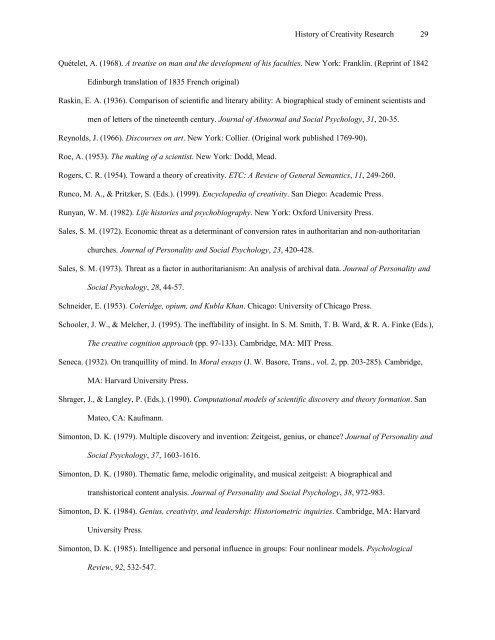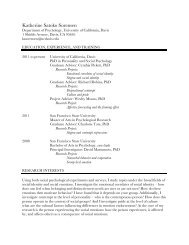The Psychology of Creativity:
The Psychology of Creativity:
The Psychology of Creativity:
Create successful ePaper yourself
Turn your PDF publications into a flip-book with our unique Google optimized e-Paper software.
History <strong>of</strong> <strong>Creativity</strong> Research 29<br />
Quételet, A. (1968). A treatise on man and the development <strong>of</strong> his faculties. New York: Franklin. (Reprint <strong>of</strong> 1842<br />
Edinburgh translation <strong>of</strong> 1835 French original)<br />
Raskin, E. A. (1936). Comparison <strong>of</strong> scientific and literary ability: A biographical study <strong>of</strong> eminent scientists and<br />
men <strong>of</strong> letters <strong>of</strong> the nineteenth century. Journal <strong>of</strong> Abnormal and Social <strong>Psychology</strong>, 31, 20-35.<br />
Reynolds, J. (1966). Discourses on art. New York: Collier. (Original work published 1769-90).<br />
Roe, A. (1953). <strong>The</strong> making <strong>of</strong> a scientist. New York: Dodd, Mead.<br />
Rogers, C. R. (1954). Toward a theory <strong>of</strong> creativity. ETC: A Review <strong>of</strong> General Semantics, 11, 249-260.<br />
Runco, M. A., & Pritzker, S. (Eds.). (1999). Encyclopedia <strong>of</strong> creativity. San Diego: Academic Press.<br />
Runyan, W. M. (1982). Life histories and psychobiography. New York: Oxford University Press.<br />
Sales, S. M. (1972). Economic threat as a determinant <strong>of</strong> conversion rates in authoritarian and non-authoritarian<br />
churches. Journal <strong>of</strong> Personality and Social <strong>Psychology</strong>, 23, 420-428.<br />
Sales, S. M. (1973). Threat as a factor in authoritarianism: An analysis <strong>of</strong> archival data. Journal <strong>of</strong> Personality and<br />
Social <strong>Psychology</strong>, 28, 44-57.<br />
Schneider, E. (1953). Coleridge, opium, and Kubla Khan. Chicago: University <strong>of</strong> Chicago Press.<br />
Schooler, J. W., & Melcher, J. (1995). <strong>The</strong> ineffability <strong>of</strong> insight. In S. M. Smith, T. B. Ward, & R. A. Finke (Eds.),<br />
<strong>The</strong> creative cognition approach (pp. 97-133). Cambridge, MA: MIT Press.<br />
Seneca. (1932). On tranquillity <strong>of</strong> mind. In Moral essays (J. W. Basore, Trans., vol. 2, pp. 203-285). Cambridge,<br />
MA: Harvard University Press.<br />
Shrager, J., & Langley, P. (Eds.). (1990). Computational models <strong>of</strong> scientific discovery and theory formation. San<br />
Mateo, CA: Kaufmann.<br />
Simonton, D. K. (1979). Multiple discovery and invention: Zeitgeist, genius, or chance? Journal <strong>of</strong> Personality and<br />
Social <strong>Psychology</strong>, 37, 1603-1616.<br />
Simonton, D. K. (1980). <strong>The</strong>matic fame, melodic originality, and musical zeitgeist: A biographical and<br />
transhistorical content analysis. Journal <strong>of</strong> Personality and Social <strong>Psychology</strong>, 38, 972-983.<br />
Simonton, D. K. (1984). Genius, creativity, and leadership: Historiometric inquiries. Cambridge, MA: Harvard<br />
University Press.<br />
Simonton, D. K. (1985). Intelligence and personal influence in groups: Four nonlinear models. Psychological<br />
Review, 92, 532-547.
















